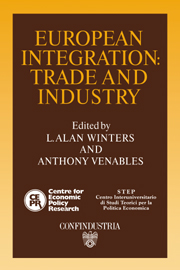Book contents
- Frontmatter
- Contents
- List of figures
- List of tables
- Preface
- Acknowledgements
- List of conference participants
- 1 European integration: trade and industry
- 2 Completing the internal market in the EC: factor demands and comparative advantage
- Discussion
- 3 External effects and Europe's integration
- Discussion
- 4 The quality and production of textiles and clothing and the completion of the internal market
- Discussion
- 5 Competition and imports in the European market
- Discussion
- 6 The structure and determinants of East–West trade: a preliminary analysis of the manufacturing sector
- Discussion
- 7 1992 and EFTA
- Discussion
- 8 Technology policy in the completed European market
- Discussion
- 9 Corporation tax, foreign direct investment and the single market
- Discussion
- 10 Japanese direct manufacturing investment in Europe
- Discussion
- Index
7 - 1992 and EFTA
Published online by Cambridge University Press: 07 September 2010
- Frontmatter
- Contents
- List of figures
- List of tables
- Preface
- Acknowledgements
- List of conference participants
- 1 European integration: trade and industry
- 2 Completing the internal market in the EC: factor demands and comparative advantage
- Discussion
- 3 External effects and Europe's integration
- Discussion
- 4 The quality and production of textiles and clothing and the completion of the internal market
- Discussion
- 5 Competition and imports in the European market
- Discussion
- 6 The structure and determinants of East–West trade: a preliminary analysis of the manufacturing sector
- Discussion
- 7 1992 and EFTA
- Discussion
- 8 Technology policy in the completed European market
- Discussion
- 9 Corporation tax, foreign direct investment and the single market
- Discussion
- 10 Japanese direct manufacturing investment in Europe
- Discussion
- Index
Summary
Introduction
The EFTA countries differ from most EC countries in three important respects. One is size: each EFTA country is very small, in sum their production amounts only to that of Britain or France. The second is openness: all EFTA countries trade extensively with the rest of the world; the EC is the largest trading partner, but they also have a large volume of trade with non-European countries. The third is reliance on comparative advantage: net trade is a substantial part of their total trade, and there is a high degree of commodity concentration in their exports.
These aspects are important in relation to the effects of 1992. It seems likely that EFTA and the EC will agree on a programme which will integrate EFTA in the internal market, at least as regards manufactured goods and services. As part of the agreement, the EFTA countries will probably have to accept (and copy) the common external trade policy of the Community. Alternatively, if an EFTA–EC agreement does not come about, most of the EFTA countries will probably join the Community. In either case, therefore, EFTA countries will become part of the internal market, and their external trade policies will have to be modified.
The internal market should give participating countries gains through (a) fuller exploitation of economies of scale, (b) increased competition, and (c) more complete exploitation of comparative advantage.
- Type
- Chapter
- Information
- European IntegrationTrade and Industry, pp. 120 - 139Publisher: Cambridge University PressPrint publication year: 1991
- 2
- Cited by



